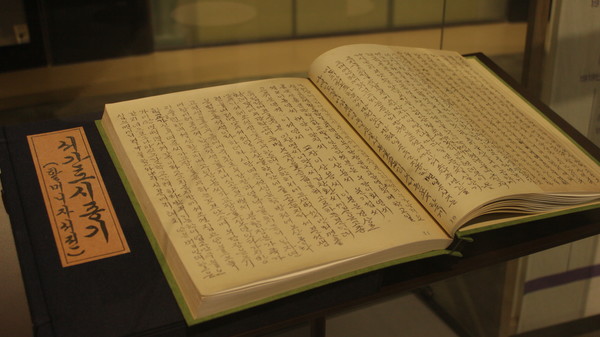A memoir rediscovering the spirits of independence activists
A SPECIAL exhibition in Lee Hoe-young Memorial Hall, Na-neun Lee Eun-sook i-da (I am Lee Eun-sook) reveals an e-book version of a handwritten memoir of Lee Eun-sook written in 1966, of her life as an independence activist, for the first time to the public. Shedding light on the lives of women independence activists and those who contributed to establishing independence societies in Jiandao[1], the exhibition honors their devotion and commemorates the feats of Lee Hoe-young and Lee Eun-sook’s families during the Japanese colonial rule in Korea.

Lee Eun-sook and her memoir, Seo gan do si jong gi (Western Gando Record)
The exhibition consists of three parts, tracing the life of Lee Eun-sook based on her memoir Seo gan do si jong gi (Western Gando Record). The first part covers her life before her marriage with Lee Hoe-young, as a well-educated woman grown up in a sa-dae-bu family[2]. It is followed by the second part, showing her life in Jiandao during the Japanese colonial rule. It covers the lives of Hoe-young’s five brothers as well, who also played a leading role as independence activists in Jiandao. The last part of the exhibition introduces her memoir and her family’s participation in Anti-Japanese movement. Her memoir traces the trajectory of her journey from a typical sa-dae-bu woman to an independence activist. Being one of the wealthiest families in Joseon, Hoe-young and Eun-sook organized and funded New People’s Association in 1906—a clandestine independence organization, which later became a crucial foothold for international Anti-Japan independence movements. They established Shin-heung Military Academy as well, an educational institute preparing for armed attacks against Japan. Their dedication to regain Korean sovereignty from colonialism through military attacks and enlightenment of the people is still highly recognized because of its influence in rooting Korean independence communities in Jiandao, leading to Korean liberation.
Seo gan do si jong gi by Lee Eun-sook, is recognized as a valuable historical source, as it is written in a traditional sa-dae-bu literary style, full of tender portrayal of her experiences and feelings. It covers anecdotes and works of Hoe-young and other independence activists around her. The memoir chronicles the lives of her family, from their migration to Jiandao to their homeward journey back to Korea after the national liberation in 1945. Her memoir uplifts the value of perseverance and courage of those who devoted their lives for liberation. Through the contribution of Eun-sook and her memoir, the spirits of independence activists are honored until this day.
[1] Jiandao: A border region of Northeast China with high ethnic Korean population, also known as Gando or Kando in Korean
[2] Sa-dae-bu: The bureaucratic class of Joseon, usually the family of scholar-officials who played a leading role in the establishment of Joseon Dynasty

